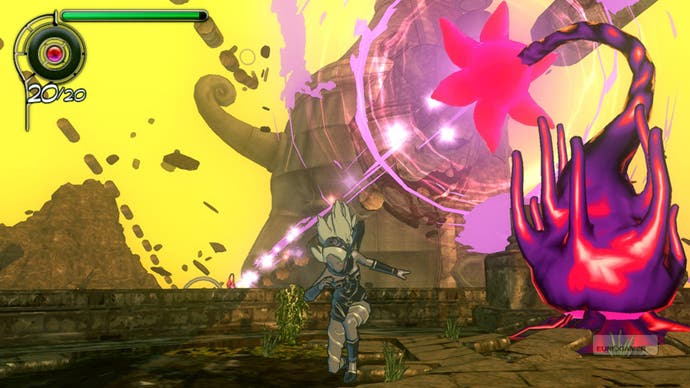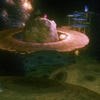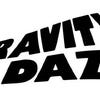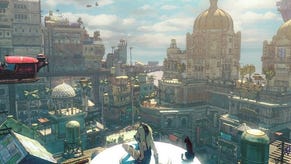Gravity Daze Review
Cat lady.
Editor's note: This is an import review of the Japanese edition of Gravity Daze, available now. The game will be titled Gravity Rush when it appears in North America and Europe, but no release date has been set for this version.
About two thirds of the way through Gravity Daze, the designers throw in one of the most entertaining mission objectives I've been given in a while: plummet. That's what it amounted to, anyway. Regardless of the exact wording, I was invited to spend the next 15 minutes falling through a magical Dickensian city perched in the sky, past gantries, tangles of piping and shimmering brickwork, and then deeper into honeycombed caverns filled with weird, fungal architecture.
Sure, there were enemies to fight along the way and glittering chains of collectables to race between - for a while, I was even joined by a sexy lady with some silly pants who really wanted to kill me - but the sequence didn't actually need any of that. I was happy just to follow the calm procession of waypoints, falling deeper and deeper through this strange world until a genuine sense of loneliness set in.
The combination of exploration and isolation puts me in mind of the night I first scaled the Agency Tower in Crackdown (albeit in reverse), or all the time I spent seeking out the darkest recesses of Jet Set Radio Future's Skyscraper District. Gravity Daze reminds me of both those games quite strongly, in fact, and that's not just down to the cel-shaded art. I think it's because all of these adventures chuck you into an interesting world and then make getting around that world spectacularly enjoyable. The designers have put the majority of their effort into the things you do the most.
Gravity Daze's missions - plummeting included - are not the most inventive I've ever played, but it's still one of the most exciting games I've encountered in ages. I've fumbled through the Japanese version - despite the fact that my Japanese vocabulary is limited to the phrase, "I'm terribly sorry, I don't speak Japanese and I'm also lost," - and I can't wait to fumble through the English version when it appears.
If you're importing Gravity Daze like we did, the good news is that you'll be able to follow the moment-to-moment action pretty well. There's no English language option I could find, but the game is surprisingly painless to get to grips with. Levelling up your stats is a simple matter of experimenting with a few menus, map and mission icons are easy to understand, objectives are rarely hard to guess at and instructions for new mechanics always include universal icons, even when they're talking about triggers and sticks and taps of the screen.
The storyline, meanwhile, will pass in a pleasantly confusing blur. As far as I can tell, Gravity Daze is concerned with a strange city menaced by a big red blob in the sky - it's called a Gravity Storm, apparently - that is steadily filling the streets with monsters. You're a gravity-flipping superhero girl who's partnered up with a magical cat, and you're pretty much there to save the day.
I'm not sure why I spent so long carrying a chair around, or why I eventually used it to furnish a nice little house I'd built in a sewer pipe, but I quite liked the whole process. Some time after that, I travelled to the centre of the earth and met a collection of Lost Boys rejects, which was nice, and every now and then a stranger phoned up to tell me about a bomb or an opportunity to hang out with Santa Claus. If you're only going to play one game this year without understanding any of the dialogue, you should probably make it Gravity Daze.
For my personal tastes, story would always be a secondary concern in this kind of adventure anyway. Gravity Daze is primarily built around geography - and its geography is dazzling.
For most of the adventure, you're exploring a wonderfully strange cityscape that seems to be permanently floating through masses of toxic cloud. It's largely non-interactive when it comes to things like shops, street furniture and doors that work, but none of that really matters. It's fun to just amble around, hunting for power-up gems and enjoying the sights. If you want to get all Frankenstein about things, I'd probably say it's taken the grime of Victorian London, the flickering stained glass of Toulouse Lautrec's Paris and the haphazard verticality of modern day Tokyo - and then brought Mucha in to do all the bargeboards and soffits.
Like Jet Set Radio Future's neighbourhoods, its plazas are filled with hipsters, futurists and dandies. Like Dark City's shape-shifting setting - oops, there's another influence - the layout's willing to change depending on your actions, with every other boss fight in the game's first half slotting another district into place. The city has its fair share of markers for story quests, dialogue sequences and side-challenges (it's probably best to think of this as an open-world action game with very light RPG elements) but the landscape's main use is as a kind of Escher-like skate park, and it only shows its true brilliance when you start to master the game's unusual approach to movement.
While you can run around and jump as if Gravity Daze was any other platformer, for most of the adventure you'll be zipping from point to point using a weird new mechanic that hinges on the Vita's shoulder triggers. One tap of the right trigger sends you off the ground and into a woozy hover, and it also brings a reticule up on the screen. You can then aim this reticule - using either a thumbstick or the Vita's wonderfully precise motion control - and press the right trigger again to zip towards your target.
Once you hit that target, it becomes the floor, which means you can stand on the fronts of buildings, the sides of buildings, and even the undersides of tunnels and streets. Gravity is consistent once you're in place, so if you're trotting along underneath a bridge and you get to the end, you'll fall upwards into space.
The only real limit to your fun is the fact that messing around with the laws of physics is managed by a meter, albeit a fairly generous one that you can upgrade over time. Meanwhile, if you lose your bearings, a tap of the left trigger will reset gravity again, sending you back to the ground with a bump and a brief puff of anime dust.

It's such a beautifully realised system that you won't even mind that the designers don't always know what to do with it. Zipping through space and calmly walking up walls is fun by itself, and as you boost your stats and are able to jet right across town with one click of the right trigger, Gravity Daze goes from being an action game with a neat traversal gimmick to a traversal game with some neat bits of action threaded into it. Vita's power, meanwhile, allows the developers to open up the draw distance and fill the streets with freaked-out witnesses.
The missions themselves do their best to match the brilliance of Gravity Daze's movement, but it was always going to be a struggle. Most chapters of this adventure revolve around racing between checkpoints, fighting hordes of enemies and then taking on a boss.
Combat's not particularly refined, but it has a rough and punchy pleasure to it. You can smack baddies around relatively well when you're stuck to the ground, but the real fun is to be had with gravity kicks - a squeeze of the trigger and you're screeching across the map shoes-first - and special moves that might turn you into a human bullet, or build a ragged vortex around you, or bombard foes with magical rocks.
Enemies worship at the altar of glowing weak spots, meanwhile, but at least their viscous and gloopy designs rope in everything from underwater eels to the flu virus. Everywhere you go, there's something horribly pretty to boot in the face, while a smart interface keeps track of threats, no matter what surface you've attached yourself to.
Each chapter will also try to throw in a few of its own ideas - you might have to stealth past guards for a bit, carry things around, chase down a random or learn a new move - but it won't hide the basic, repetitive nature of what you're up to most of the time. Elsewhere, some sequences take you away from the city entirely and into a series of equally strange environments that range from pale deserts or geometrical planes built of floating cubes to a model of the solar system made out of fungus and seashells.
Occasionally, these places strip you of your powers entirely and, towards the end of the game, you'll head to a new, not quite as interesting, location and spend a fair amount of time there. Gravity Daze's rather blundering approach to variety is to be applauded, but it's never entirely convincing. It's always a relief to get back to the city and back into the sky.

This is when the game's at its happiest: when it's ditched any attempts at structural diversity and is just allowing you to enjoy your gravity-flipping abilities and the tireless detailing of the world you've been thrust into. Detailing such as the city's trains, for example, which draw you along whimsical curlicues of art nouveau brass as you head from one district to the next. Detailing such as the glossy pink neon of the enemy attack points that shatter like glass under your boots, and the comic book cut-scenes done in a harmonious blend of French and Japanese art styles.
Then there's the animation, delivering fights packed with tumbles and flourishes, the bosses that are brought to their knees with lavish beatdowns and finished with a curt little prod of the finger, and the soundtrack that's equally comfortable with summer jazz riffs and monster-movie swells. Django would be proud and Godzilla wouldn't be too disappointed. Funny instrument, the accordion.
That's why, as the momentum builds, as your powers increase, and as the parts of the city slide silently into place like giant freighters coming home to dock, Sony's game turns into something much more coherent than its scattershot reference points and missions might suggest. Sure, it's a little repetitive at times, but the things it asks you to repeat are wonderful, and it's built by a design team that's in love with the simple pleasure of movement.
If you're drawn to games by the satisfaction offered by their simplest mechanics, Gravity Daze is a total delight. You can spin between rooftops and freeze yourself in mid-air; you can drop from the sky and never hit the ground.





















